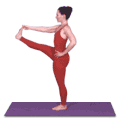
There was a time when the term Yoga brought up images of enlightened yogi's in complicated asanas that looked like odd and perhaps even dangerous contortions to the layman. But recent years and the embrace of the ancient practice by mainstream culture has transformed visions of aging yogis into shapely young yoga instructors leading class fulls of equally fit students through a regimen of poses delivering less enlightenment and more strength training. How did it happen? How did a 5000 year old discipline become so trendy and well, watered down? Now a new wave of business' are taking advantage of the Yoga craze, and bringing it to the next level of mass culture by launching the ancient practice to the edge of modern technology - using new platforms to deliver ancient wisdom.
Just today it was announced that Vodafone is offering a package wherein the user can download unlimited Yoga videos featuring Indian celebrity Shilpa Shetty in one hour. The pack also contains a step-by-step procedure for each Asana right on your little handy. Not quite sure how one is suppose to really get into a pose and "tune inward" to experience to benefit of the posture, while keeping pace with your handheld. But mobile operators in India seem to believe in the idea signing on in rapid order.
Then there is "Let's YOGA!" (Konami, $20), for you Nintendo DS handheld game console. The "wellness game" offer a virtually unlimited number of Yoga workouts that can be taken on the go. The game feature a rather uninspiring animated yogi model (that they sell you on by telling you can you dress the animated model how you want) who is suppose to jump start your yoga practice. I remain skeptical.
For those of you less on the go, and more tied to your keyboard, there is My Yoga Online.com, an online destination that offers a wide array of video taking you from individual postures to entire yoga classes. The video are actually pretty good. Granted nothing can replace doing a practice with a great instructor (unless you are confident enough to go solo), the site is a nice resource to simply introduce you to certain poses that then you can integrate into your practice.
Who knows how much technology is actually inspiring folks to get down on their mat, reconnect, get centered and embrace a yoga practice in their life? Perhaps these new "wellness content plays" are more impactful in terms of marketing the idea of yoga and inspiring an interest in the discipline. Eventually to truly understand the benefits of yoga, one must completely "unplug" and tune in - not simply get wired up or wireless. At some point the only content that one should focus on in Yoga, is the content of one's inner self.


 so you can reach out and steady yourself with your left hand if necessary.) [Figure 1] Take a moment to explore your balance in this simple standing pose. Is your weight evenly distributed between the right and left foot? Between the ball of the foot and the heel? Spread the toes and actively draw the kneecaps upward to firm the legs.
so you can reach out and steady yourself with your left hand if necessary.) [Figure 1] Take a moment to explore your balance in this simple standing pose. Is your weight evenly distributed between the right and left foot? Between the ball of the foot and the heel? Spread the toes and actively draw the kneecaps upward to firm the legs. on one leg for five to 10 long breaths. [Figure 2] Going this far might be challenge enough! Rest your eyes softly but steadily on a single point to help establish and maintain your balance.
on one leg for five to 10 long breaths. [Figure 2] Going this far might be challenge enough! Rest your eyes softly but steadily on a single point to help establish and maintain your balance. Let the pose unfold from your core, unfurling your leg like a flower blossoming out of your belly. Keep the left leg strong and straight. Resist the impulse to hunch forward over the lifted leg. Instead, keep the spine reaching toward the sky. Continue to drop the right hip down so the hips remain square and level with each other.
Let the pose unfold from your core, unfurling your leg like a flower blossoming out of your belly. Keep the left leg strong and straight. Resist the impulse to hunch forward over the lifted leg. Instead, keep the spine reaching toward the sky. Continue to drop the right hip down so the hips remain square and level with each other.